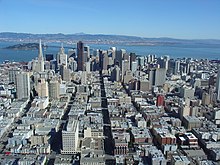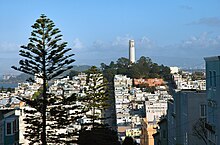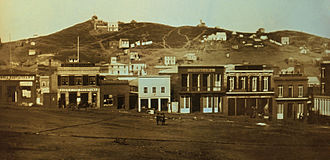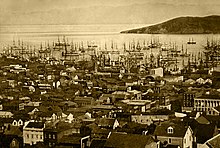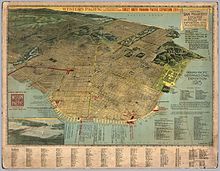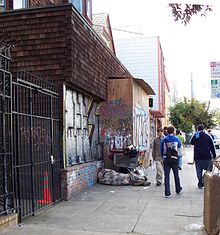History of the City of San Francisco
The history of the city of San Francisco in California was significantly influenced by its location on the Pacific coast. It became an important center for maritime trade and the location for Fort Mason , the main embarkation port for military operations in the Pacific. San Francisco is the fourteenth largest city in the United States and is characterized by rapid economic change and cultural diversity.
Pre-colonial history
The area of today's US state California has been populated for over 10,000 years. When the first Europeans arrived, the Yelamu , a tribe from the Ohlone language family, inhabited the San Francisco area.
The frequent fog over San Francisco Bay caused the early explorers, including Sir Francis Drake , to sail past the Golden Gate and San Francisco Bay long remained undiscovered.
The first Europeans on the San Francisco Bay
In the course of the Spanish conquests in Central and North America, the explorer Gaspar de Portolà was the first to move overland in 1769 to what is now the state of California, which was then part of the Spanish colony of New Spain . On November 2nd, he reached San Francisco Bay .
Seven years later, in the course of the establishment of the Spanish missions in California, the Mission San Francisco de Asís (also called Mission Dolores) was founded by Junípero Serra and the Presidio was established for this purpose. The Franciscan Serra is considered the founder of San Francisco.
In the years that followed, several other European conquerors visited the bay, including the French Jean-François de La Pérouse and the English George Vancouver . A few Russians also settled in the area, mostly hunters (halting their advance was one of the main reasons for the Spanish advance north). From 1770 on, Russia colonized the area from Alaska to Fort Ross in Sonoma , just north of the bay. The name Russian Hill , a central residential area in San Francisco, is reminiscent of the Russian fur traders and seamen.
After the Mexican War of Independence , California became part of Mexico . In 1835 the Englishman William A. Richardson built the first courtyard outside the immediate vicinity of Mission Dolores, near a boat landing stage in what is now Portsmouth Square . Among other things, he is responsible for the street plan of the village, which is now attracting more and more settlers and which was initially called Yerba Buena (after a species of mint that occurs in the area ). In 1838 Richardson was given a large piece of land in Marin County , where he moved in 1841. The Richardson Bay is named after him.
In the same year England considered buying California from Mexico, because the strategic importance for the Pacific had been recognized. Nothing came of that, however, and so San Francisco became one of the most strategically important ports in the USA.
On July 31, 1846, the population of Yerba Buena suddenly doubled when 240 Mormons, led by Samuel Brannan , docked on the Brooklyn ship . Brannan, himself a member of The Church of Jesus Christ of Latter-day Saints , would later become best known for his accounts of the California gold rush . He is considered to be California's first gold millionaire.
In the Mexican-American War , John Drake Sloat claimed California for the United States . On July 9, 1846, John Berrien Montgomery and Henry Bulls Watson arrived at Yerba Buena on the USS Portsmouth and hoisted their flags over the city center. In August of the same year, Lt. Washington A. Bartlett named Alkald of Yerba Buena. On January 30, 1847, the place was officially renamed San Francisco at the request of Bartlett . The name is a reference to Francis of Assisi , the patron saint of the Franciscan religious family . California, and with it San Francisco , officially became part of the United States in 1848 as a result of the Treaty of Guadalupe Hidalgo , which ended the Mexican-American War. San Francisco was soon classified as both a city and a county by the California state .
Located at the far end of a peninsula, San Francisco lacked two important raw materials for a 19th century settlement: water and firewood. The city's residents were therefore forced to bring these goods into the city. Early on, people began to fill up coastal areas in order to build houses there.
The California gold rush
The California gold rush that began in 1848 had a lasting impact on the city. First of all, it led to explosive population growth. Between January 1848 and December 1849, San Francisco's population rose from 1,000 to over 25,000, even though the city itself was far from the gold mines. The extreme growth continued into the 1850s, especially when silver was still being found. Urban planning was sometimes overwhelmed by the growth, which led to (by American standards) sometimes very narrow streets that still hinder traffic in the old town today. San Francisco became the largest city west of the Mississippi, a title that was lost to Los Angeles in 1920.
A particularly large number of immigrants came from China , as the Chinese workers who had taken part in the construction of the first transcontinental railroad settled in San Francisco after it was completed. Strict racial laws , such as the Chinese Exclusion Act , only allowed them to settle within narrowly defined boundaries within the city. Now called Chinatown, this neighborhood is the largest of its kind in California. About a fifth of the city's residents are Sino-Americans , one of the largest Asian populations outside of China.
Many of today's world-famous brands and products were created at that time, such as Levi Strauss & Co. , Ghirardelli Chocolate Company and Wells Fargo Bank . Several tycoons made a talking point, although sometimes more as " robber barons " (Engl .: Robber barons ), including the Big Four ( Charles Crocker , Mark Hopkins , Collis P. Huntington , and Leland Stanford ), both the railway system of the West and politics dominated at will and did not shrink from violence against their construction workers. Where these barons built their mansions in San Francisco are now famous and expensive hotels like the Huntington .
The uncontrolled immigration of mostly male treasure hunters led to conditions in San Francisco that were in no way inferior to the Wild West . The city was essentially anarchy , although there were properly elected organs at both local and state (state) levels. Their representatives were corrupt , however, and crooks - these had fled in large numbers from the east to the west, where they were undetected and undisturbed - got away with mild or no punishment. San Francisco, which at that time was built almost entirely of wood, burned down at least three times in substantial parts between 1849 and 1851. It is believed that the fires were often started, for example to destroy the warehouses of competitors. However, the arsonists were persecuted or even punished in the rarest of cases.
When some of the opposition politicians were finally shot on the street, resistance formed. Under the leadership of Samuel Brannan , the first so-called Committee of Vigilance ( Vigilance Association ) was formed, which set itself the goal of taking the law into its own hands. Twice, in 1851 and 1856, this eminent man-made organization met to enforce the law for about half a year each. On both occasions, several criminals who had been caught were convicted in trial-like proceedings and immediately hanged , which temporarily ensured peace.
The city of San Francisco was the county seat of San Francisco County from 1849 to 1856. After that, due to the problems with lawlessness described, the California state divided the county. A line was drawn straight across the peninsula north of San Bruno Mountain. Everything south of it became the new San Mateo County , the part north of it became the city county of San Francisco, the only one in California.
In the fall of 1855, a ship brought refugees from a cholera epidemic from the Far East to San Francisco (historiography disagrees as to whether it was the SS Sam or the SS Carolina - both brought refugees from an epidemic to the city, one of the Ships in 1850, the other in 1855). Because the city grew significantly faster in the wake of the gold rush than the infrastructure actually needed and, in particular, the sanitary facilities , a serious cholera epidemic broke out in San Francisco itself. At that time, the state would actually have been responsible for health care, but it felt overwhelmed and delegated responsibility to the counties. That led to the county hospital system that still exists in California today. In San Francisco itself, Sisters of Charity were entrusted with running a hospital because they had shown themselves to be very efficient during the epidemic. In 1857 the Order opened St. Mary's Hospital on Stockton Street, the first Catholic hospital west of the Rocky Mountains . In 1905 they bought a piece of land on the corner of Fulton and Stanyan Streets. The local St. Mary's Medical Center is the oldest permanently active hospital in San Francisco.
working conditions
For working conditions and industrial struggles in the 19th and early 20th centuries, see the articles History of California and Labor Movement in the United States .
Paris of the West

By 1890, San Francisco suffered again from clientelism and corruption. New political reforms were urgently needed. The populist Adolph Sutro was then elected mayor in 1894 without actually campaigning. Unfortunately, apart from the opening of the sutro baths , he made little substantial progress for the city.
Sutro's successor, James D. Phelan , who was elected in 1896, was more successful. He was able to enact a new law that made it possible to issue government bonds . This enabled him to raise enough funds to renew the city's sewer system and open seventeen new schools, two new parks, a hospital and a library. After he resigned from the mayor's office in 1901, he was interested in beautifying the city. San Francisco was to be extensively modernized and become the Paris of the West . After the San Francisco Art Association asked him to prepare a plan to beautify the city, he hired the famous architect Daniel Burnham . Phelan and Burnham's plan was ambitious, as it envisaged a renovation process that would take over 50 years to provide the city with wide boulevards and squares. Some of the proposals were implemented, such as the new opera house, the subway under Market Street and the Embarcadero beach boulevard .
In 1900, San Francisco was hit again by an epidemic, this time by the plague brought in by ship . Since it was wrongly assumed that the bodies of those who died of the disease were still contagious (and possibly also because of promising land speculations), all cemeteries were banned from the city center and moved to what is now Colma . Fifteen blocks in Chinatown were quarantined as political leaders argued over the right steps to take to contain the plague. The plague was not eradicated until 1905. The cemeteries and the dead continued to be brought to Colma, where the number of the dead now exceeds the number of the living by more than a thousand times. Only the Columbarium of San Francisco and the historic cemeteries in Mission Dolores and at the Presidio were allowed to remain.
Around the turn of the century, one of the most extensive and high-capacity public transport systems in the world was built in San Francisco. Between 1873 and the earthquake of 1906, in which substantial parts of the facilities were destroyed, the network of the San Francisco Cable Cars was created , the remaining three lines of which are now one of the city's most important tourist attractions, listed as a National Historic Landmark and next to the Golden Gate -Bridge are the second landmark of the city. At the turn of the century, no fewer than 8 railway companies were competing for customers. At peak times, a car would leave the central stop by the Ferry Building every 15 seconds. An enormous frequency, even by today's standards.
The great earthquake of 1906
On April 18, 1906, a severe earthquake struck the city of San Francisco. The earth shook along the San Andreas Rift between San Juan Bautista and Eureka , with the epicenter just off the coast of San Francisco. Today the magnitude of the earthquake is given as around 7.8 on the Richter scale . The earthquake tore up trenches that quickly filled with water, and gas pipes were also exposed and ignited by the quake, which led to the largest city fire in the city's history, which probably massively exceeded the damage of the earthquake itself and continued for several days Ate houses in the city. The official number of deaths was initially given as 478, but this no longer stands up to recent findings and was later corrected to over 3000. Presumably the political authorities tried not to add to the fear of reconstruction with the understatement.
reconstruction

Reconstruction plans were drawn up practically immediately after the earthquake. Again Daniel Burnham submitted ambitious plans, with wider avenues in the style of Georges-Eugène Haussmann and wide entry and exit roads . The plan was rejected again, however, because it would have had too radical cuts, especially in the property of various landowners. However, some of the proposals have been implemented, such as the subway under Market Street and the visitor-friendly redesign of Fisherman's Wharf . The Coit Tower on Telegraph Hill in the middle of the city also goes back to Burnham's initiative.
In 1907 and 1908, city politics was shaken by bribery scandals involving so-called public service corporations . The careers of Mayor Eugene Schmitz and Abe Ruef ended in prison.
In 1915 the Panama-Pacific International Exposition took place in San Francisco , officially to celebrate the opening of the Panama Canal . However, the exhibition was also intended to show how the city rose from the ashes like a phoenix . With the exception of the Palace of Fine Arts , all of the buildings erected for this purpose were torn down after the exhibition and today's Marina District was built on the site .
Monumental construction projects
After the reconstruction, several monumental structures were erected, which today shape the image of San Francisco. In 1936 the San Francisco - Oakland Bay Bridge was opened, which connects the San Francisco peninsula with Oakland to the east . In 1937 the Golden Gate Bridge , which has become the city's landmark, was opened and in 1939 the Golden Gate International Exposition was held.
Second World War
During World War II , Fort Mason in San Francisco was the main port of departure for American operations in the Pacific War . Hundreds of thousands of tons of material and thousands of soldiers were embarked here. Liberty ships and Victory ships were assembled in several ports around San Francisco Bay . The SS Jeremiah O'Brian , one of the last seaworthy ships of that time, can be visited today at the pier in San Francisco.
Opened in 1932, the War Memorial Opera House became the center of several important post-war treaty deals. In 1945 the conference for the establishment of the United Nations took place here. In the nearby Herbst Theater , the Charter of the United Nations was signed on June 26th . The San Francisco peace treaty , which formally ended the war with Japan , was formulated here six years later and finally signed.
post war period
Many soldiers who returned to the war and home via San Francisco settled here after the war. This created the Sunset District and Visitacion Valley . Caltrans began an aggressive highway construction policy in the Bay Area during this period . However, the company soon encountered considerable resistance from the population, as the high population density meant that practically every new street had to lead to the resettlement of many residents. Caltrans tried to get around this problem (and also spending on land purchases) by creating multi-story highways. The engineers then constructed strangely arranged roads that also turned out to be seismically unstable. In 1956, the City Council ( Board of Supervisors ) decided to forego further highway construction, an event known as the Freeway Revolt . Although some minor improvements were still being made, the city essentially stuck to its anti-highway policy. To this day it has one of the narrowest road systems in the USA. When the Embarcadero Freeway and the Central Freeway were also destroyed by the Loma Prieta earthquake in 1989 , the citizens decided in several votes not to rebuild them. Instead, houses were built again in their place. This was particularly successful on the Embarcadero , which has now become a tourist center.
Renewals
In the 1950s, Mayor George Christopher commissioned Harvard graduate Justin Herman to head a working group to revisit urban development. Again, the plans were ambitious and Herman began an aggressive campaign to tear down so-called "blighted areas" of the city. In truth, however, these were settlements predominantly inhabited by non-white workers. He tore down large parts of the city through expropriations , relocated the local population to other quarters or to Oakland and built modern buildings on the site. This brought Herman serious racist allegations, which, however, had no material effect. He planned the construction of the Embarcadero Center , the Embarcadero Freeway , Japantown and the Yerba Buena Garden .
Counterculture
San Francisco is often referred to as the center of American counterculture . It is considered the birthplace of the hippie culture, which reached its climax in 1967 in the Haight-Ashbury -Quartier in the so-called Summer of Love . Many later known rock 'n' roll groups made a name for themselves here, including Jefferson Airplane , Grateful Dead .
In the 1980s and 1990s punk and thrash metal styles became fashionable, along with the rave scene. In 2004 the first Love Parade took place in San Francisco , modeled on Berlin .
During the war, San Francisco became a center of the gay movement in America. The American military selectively singled out gays and lesbians between 1941 and 1945 and dishonorably discharged them from service. Over 9,000 homosexual soldiers were released, a large proportion of whom remained in San Francisco. In the 1960s, many more homosexuals moved to San Francisco, not only because of the tolerance towards them that has now become known, but also because of the metropolis’s strongly left-dominated politics. These new arrivals were buying up rundown properties, particularly in Haight-Ashbury, and putting them back in order. Later, when drugs and violence were the order of the day in Haight, they moved to the Castro district , which became the gay Mecca . This led to conflicts with local residents. On November 27, 1978, Dan White murdered then Mayor George Moscone and Harvey Milk, the first public representative who was open to his homosexual tendencies . These murders led to open acts of violence and rallies in the city. In the 1980s, gay men in San Francisco were particularly hard hit by AIDS . Today the city is home to around 15 percent homosexuals. That is the largest percentage among any major American city.
Manhattanization and homelessness
During the reign of Mayor Dianne Feinstein (1978–1988), San Francisco saw a building development known as Manhattanization , ie the construction of a number of skyscrapers, especially in the financial district . These skyscrapers clearly dominate the cityscape today, which led to opposition to the building plans even then. Similar to the freeway revolts two decades earlier, there was now a kind of skyscraper revolt , a skyscraper revolt. This forced the city to issue strict requirements for the construction of new such buildings. These slowed down the construction of new skyscrapers for a certain time, but due to a lack of space, the rules were relaxed again in the 21st century. In the meantime the opposition has decreased significantly, so that several new skyscrapers have been built or are at least planned.
A new problem that has arisen since the 1980s is increasing homelessness . There are many reasons for this, including the closure of state institutions for the mentally handicapped and the increasing presence of open drug scenes . Coupled with San Francisco's attractive surroundings and affluent policies, the problem became serious. Several mayors tried to get it under control. Art Agnos (1988–92) set up a camp for the homeless in the Civic Center Park, hence the name Camp Agnos . The project failed, however, so that he lost re-election in 1991. He was succeeded by Frank Jordan , who named his program Matrix . He relocated the homeless through massive police operations, but only managed to get them to simply settle all over town. His successor, Willie Lewis Brown , was able to stay out of the affair by largely ignoring the problem. The current mayor Gavin Newsom runs the controversial Care Not Cash program, with which he wants to make the city less attractive as a “public welfare work”. The homeless are to be given affordable housing and forced to participate in drug rejection programs and training programs.
Loma Prieta earthquake
On October 17, 1989, a quake measuring 7.1 on the Richter scale shook the area. The epicenter was about 113 kilometers south of San Francisco. The quake severely damaged many of the city's highways, including the aforementioned Embarcadero Freeway and the Central Freeway. These were then torn down and not rebuilt. There was also serious damage in the Marina District and the South of Market District .
The dot-com boom
During the dot-com boom of the 1990s, many entrepreneurs and software developers moved to the city (San Francisco is on the edge of the high-tech area known as Silicon Valley ), followed by the associated marketing specialists and salespeople. Massive gentrification set in and rents rose enormously. This meant that many people, families and companies had to move away from the city. San Francisco today has the lowest proportion of children and teenagers of any major American city, with only 14.5 percent of all under 18s.
When the dot-com bubble burst in 2001 , the previous development was partially reversed. South of Market , where a particularly large number of dot-com companies were based, was now an office district full of "for rent" signs. The city now experienced the largest population decline in its history. 30,000 residents moved out of the city in just a few years, which has somewhat put the rents back into balance. But still San Francisco remains an expensive city.
present
By 2003 the urban economy had recovered to some extent, supported by the emerging tourism. The demand for apartments and office space increased again, and with it the rents. In order to get the problem under control, height restrictions for buildings have been relaxed. Several construction projects are currently under construction or planned, including the Millennium Tower and expansion of the transport infrastructure. With BART and Muni, San Francisco has one of the most sophisticated public transport systems in North America, and they actually carry a significant number of passengers. The fact that the cable cars and the F-Line are special tourist attractions certainly played an important role in maintaining public transport, in addition to the historically very narrow streets (by American standards).
Historical population figures
Historical San Francisco City Population Statistics:
- 1852: 34.776
- 1860: 56.802
- 1870: 149.473
- 1880: 233.959
- 1890: 298.997
- 1900: 342.782
- 1910: 416.912
- 1920: 506.676
- 1930: 634.394
- 1940: 634.536
See also
Web links
- San Francisco History - Various articles covering the history of the city
- Historical images of the city , in the Central Pacific Railroad Photographic History Museum
- Historical pictures of the city and the great earthquake of 1906 by JB Monaco, a photographer of the time
- Map and timeline of events from San Francisco history.
Individual evidence
- ↑ Randall Milliken: A Time of Little Choice: The Disintegration of Tribal Culture in the San Francisco Bay Area, 1769-1810 . Ballena Press, 1995, ISBN 978-0-87919-131-3 (English, 364 pages, [1] ).
- ^ Visitors: San Francisco Historical Information . City and County of San Francisco. Archived from the original on March 31, 2008. Info: The archive link was automatically inserted and not yet checked. Please check the original and archive link according to the instructions and then remove this notice. Retrieved September 3, 2006.
- ↑ Jean-François de Galaup, comte de La Pérouse; Yamane, Linda Gonsalves; Margolin, Malcolm: Life in a California Mission: Monterey in 1786: The Journals of Jean Francois De La Perouse . ISBN 0-930588-39-8 .
- ↑ For the population census of Revillagigedo, see The Census of 1790, California , California Spanish Genealogy, accessed August 4, 2008 in The Census of 1790: A Demographic History of California , Menlo Park: Ballena Press, 1998, pp. 75-105. ISBN 9780879191375 .
- ↑ De La Perouse, Life in a California Mission .
- ^ Vancouver's Report Presidio of San Francisco, National Park Service.
- ↑ From the 1820s to the Gold Rush . The Virtual Museum of the City of San Francisco. Retrieved August 28, 2006.
- ^ Porter, Andrew: The Oxford History of the British Empire Volume III: The Nineteenth Century . Oxford University Press, 1999, ISBN 0-19-820565-1 .
- ^ History of Yerba Buena Gardens . Yerba Buena Gardens. Archived from the original on October 2, 2013. Info: The archive link was inserted automatically and has not yet been checked. Please check the original and archive link according to the instructions and then remove this notice. Retrieved August 28, 2003.
- ↑ Dennis M. Powers: Treasure Ship: The Legend and Legacy of the SS Brother Jonathan . Kensington / Citadel Press, New York, New York 2006.
- ↑ US Census Population of the 100 largest cities and other urban places in the United States: 1790 to 1990 . Retrieved April 20, 2006.
- ^ Wiley, Peter Booth: National Trust Guide San Francisco . John Wiley & Sons, Inc., 2000, ISBN 0-471-19120-5 .
- ^ San Francisco Cemeteries . Retrieved July 12, 2005.
- ^ Berube, Allan: Coming Out Under Fire The History of Gay Men and Women in World War Two . Free Press, 1990, ISBN 0-7432-1071-9 .
- ↑ SFobserver.com ( Memento of the original from January 4, 2006 in the Internet Archive ) Info: The archive link was inserted automatically and has not yet been checked. Please check the original and archive link according to the instructions and then remove this notice.
- ↑ 1940 Census, Population Report, Vol. 1, pp. 32-33
- ↑ The numbers from 1850 were lost in a town fire. The number is from the California Census of 1852
